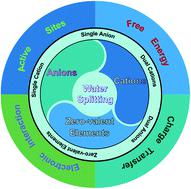当前位置:
X-MOL 学术
›
J. Mater. Chem. A
›
论文详情
Our official English website, www.x-mol.net, welcomes your feedback! (Note: you will need to create a separate account there.)
Compositional engineering of sulfides, phosphides, carbides, nitrides, oxides, and hydroxides for water splitting
Journal of Materials Chemistry A ( IF 11.9 ) Pub Date : 2020-06-19 , DOI: 10.1039/d0ta05038e Yiqiang Sun 1, 2, 3, 4 , Tao Zhang 5, 6, 7, 8, 9 , Cuncheng Li 1, 2, 3, 4 , Kun Xu 4, 10, 11, 12 , Yue Li 5, 6, 7, 8, 9
Journal of Materials Chemistry A ( IF 11.9 ) Pub Date : 2020-06-19 , DOI: 10.1039/d0ta05038e Yiqiang Sun 1, 2, 3, 4 , Tao Zhang 5, 6, 7, 8, 9 , Cuncheng Li 1, 2, 3, 4 , Kun Xu 4, 10, 11, 12 , Yue Li 5, 6, 7, 8, 9
Affiliation

|
Global environmental and energy crises have attracted wide attention and led to ongoing efforts to search for sustainable energy storage and conversion systems that can meet the energy needs of modern society. Electrocatalytic water splitting driven by renewable-energy-resource-derived electricity has been identified as a potential and practical strategy for future energy generation. Exploring nonprecious-metal-based electrocatalysts with high activity and tolerance is the prerequisite for the widespread application of this energy storage model. Heteroatom-regulated electrocatalysts with controllable components as well as electronic structure have unlimited potential toward the pursuit of high-efficiency electrocatalysts and they have been recognized as the perfect platform for establishing clear structure–property relationships. Therefore, in this review, the compositional engineering of recently reported transition-metal-compound-based water-splitting catalysts with multiple anion, cation, and zero-valent-element regulations were summarized. Particular emphasis is placed on the unique role of different doping configurations for each doping type in enhancing the electrocatalytic activities and stability of heteroatom-regulated electrocatalysts by exposing the active sites, regulating the electronic structure, and promoting the electrical conductivity. Finally, some personal perspectives on the design and development of heteroatom-doped electrocatalysts are shared to indicate the possible prospective development of transition-metal-compound-based electrocatalysts.
中文翻译:

用于水分解的硫化物,磷化物,碳化物,氮化物,氧化物和氢氧化物的成分工程
全球环境和能源危机已引起广泛关注,并导致人们不断努力寻找可满足现代社会能源需求的可持续能源存储和转换系统。由可再生能源衍生的电力驱动的电催化水分解已被确定为未来能源生产的潜在和实用策略。探索具有高活性和高耐受性的非贵金属基电催化剂是该储能模型得到广泛应用的前提。具有可控成分和电子结构的杂原子调节电催化剂在追求高效电催化剂方面具有无限的潜力,并且它们被认为是建立清晰的结构-性质关系的理想平台。因此,在这篇综述中,总结了最近报道的具有多种阴离子,阳离子和零价元素规定的过渡金属化合物基水分解催化剂的组成工程。特别强调的是,每种掺杂类型的不同掺杂结构在通过暴露活性位点,调节电子结构和提高导电性来增强杂原子调节的电催化剂的电催化活性和稳定性方面的独特作用。最后,分享了一些关于杂原子掺杂电催化剂设计和开发的个人观点,以表明可能基于过渡金属化合物的电催化剂的未来发展。总结了最近报道的具有多种阴离子,阳离子和零价元素规定的过渡金属化合物基水分解催化剂的组成工程。特别强调的是,每种掺杂类型的不同掺杂结构在通过暴露活性位点,调节电子结构和促进电导率来增强杂原子调节的电催化剂的电催化活性和稳定性方面的独特作用。最后,分享了一些关于杂原子掺杂电催化剂设计和开发的个人观点,以表明可能基于过渡金属化合物的电催化剂的未来发展。总结了最近报道的具有多种阴离子,阳离子和零价元素规定的过渡金属化合物基水分解催化剂的组成工程。特别强调的是,每种掺杂类型的不同掺杂结构在通过暴露活性位点,调节电子结构和促进电导率来增强杂原子调节的电催化剂的电催化活性和稳定性方面的独特作用。最后,分享了一些关于杂原子掺杂电催化剂设计和开发的个人观点,以表明可能基于过渡金属化合物的电催化剂的未来发展。特别强调的是,每种掺杂类型的不同掺杂结构在通过暴露活性位点,调节电子结构和促进电导率来增强杂原子调节的电催化剂的电催化活性和稳定性方面的独特作用。最后,分享了一些关于杂原子掺杂电催化剂设计和开发的个人观点,以表明可能基于过渡金属化合物的电催化剂的未来发展。特别强调的是,每种掺杂类型的不同掺杂结构在通过暴露活性位点,调节电子结构和促进电导率来增强杂原子调节的电催化剂的电催化活性和稳定性方面的独特作用。最后,分享了一些关于杂原子掺杂电催化剂设计和开发的个人观点,以表明可能基于过渡金属化合物的电催化剂的未来发展。
更新日期:2020-07-14
中文翻译:

用于水分解的硫化物,磷化物,碳化物,氮化物,氧化物和氢氧化物的成分工程
全球环境和能源危机已引起广泛关注,并导致人们不断努力寻找可满足现代社会能源需求的可持续能源存储和转换系统。由可再生能源衍生的电力驱动的电催化水分解已被确定为未来能源生产的潜在和实用策略。探索具有高活性和高耐受性的非贵金属基电催化剂是该储能模型得到广泛应用的前提。具有可控成分和电子结构的杂原子调节电催化剂在追求高效电催化剂方面具有无限的潜力,并且它们被认为是建立清晰的结构-性质关系的理想平台。因此,在这篇综述中,总结了最近报道的具有多种阴离子,阳离子和零价元素规定的过渡金属化合物基水分解催化剂的组成工程。特别强调的是,每种掺杂类型的不同掺杂结构在通过暴露活性位点,调节电子结构和提高导电性来增强杂原子调节的电催化剂的电催化活性和稳定性方面的独特作用。最后,分享了一些关于杂原子掺杂电催化剂设计和开发的个人观点,以表明可能基于过渡金属化合物的电催化剂的未来发展。总结了最近报道的具有多种阴离子,阳离子和零价元素规定的过渡金属化合物基水分解催化剂的组成工程。特别强调的是,每种掺杂类型的不同掺杂结构在通过暴露活性位点,调节电子结构和促进电导率来增强杂原子调节的电催化剂的电催化活性和稳定性方面的独特作用。最后,分享了一些关于杂原子掺杂电催化剂设计和开发的个人观点,以表明可能基于过渡金属化合物的电催化剂的未来发展。总结了最近报道的具有多种阴离子,阳离子和零价元素规定的过渡金属化合物基水分解催化剂的组成工程。特别强调的是,每种掺杂类型的不同掺杂结构在通过暴露活性位点,调节电子结构和促进电导率来增强杂原子调节的电催化剂的电催化活性和稳定性方面的独特作用。最后,分享了一些关于杂原子掺杂电催化剂设计和开发的个人观点,以表明可能基于过渡金属化合物的电催化剂的未来发展。特别强调的是,每种掺杂类型的不同掺杂结构在通过暴露活性位点,调节电子结构和促进电导率来增强杂原子调节的电催化剂的电催化活性和稳定性方面的独特作用。最后,分享了一些关于杂原子掺杂电催化剂设计和开发的个人观点,以表明可能基于过渡金属化合物的电催化剂的未来发展。特别强调的是,每种掺杂类型的不同掺杂结构在通过暴露活性位点,调节电子结构和促进电导率来增强杂原子调节的电催化剂的电催化活性和稳定性方面的独特作用。最后,分享了一些关于杂原子掺杂电催化剂设计和开发的个人观点,以表明可能基于过渡金属化合物的电催化剂的未来发展。



























 京公网安备 11010802027423号
京公网安备 11010802027423号